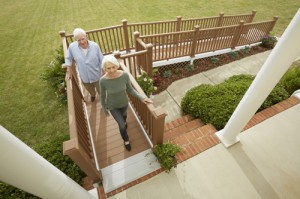 Guest post by Patricia Moore for Lowe’s
Guest post by Patricia Moore for Lowe’s
Accessibility in a home–both indoors and out–helps people maintain independence while ensuring safety and security. Simple changes and upgrades to a home can help loved ones stay longer in their homes.
Indoor flooring options
- Flooring can help with mobility. Wood and ceramic tile floors are much easier to walk on than thickly padded carpet.
- Safe flooring features should be considered, including low or no thresholds (use a beveled strip for heights of 1/4 inch or more), non-slip and non-glare surfaces such as cork flooring, and low-pile carpets or rugs.
Ideally, have an accessible bedroom, bath, kitchen, living area, and laundry room on the first floor with 42-inch-wide hallways and a minimum of 32-inch-wide doorways. Install swing-clear hinges to widen openings.
Illuminate the home to provide maximum-layered lighting
- Task lighting is important for brightening work spaces.
- Exterior walkways, porches, halls, and stairs should also be well-lighted.
- Lighting fixtures should include dimmers located 18 to 48 inches from the floor.
- Lamps, recessed ceiling lights, and wall sconces can also direct more light.
Increase safety features in bathrooms
Thoughtful changes will make bathrooms–one of the leading rooms for falls and accidents–safer and accessible.
Many bath products today are functional and stylish; for example, grab bars have more than one use–they double as a towel rack.
- A zero-threshold shower with a built-in transfer seat helps when mobility is limited.
- Non-slip bathmats to prevent slips and falls.
- Scald-control faucets to protect against burns.
- A hand held, adjustable shower head.
- An ADA-compliant toilet with side transfer space.
- A wall-mount sink with space for a wheelchair.
- A vanity with open cabinetry underneath.
- Textured floor tile with a 5 PEI rating is durable and slip resistant.
Innovative, do-it-yourself access ramps
 The most important aspect of home accessibility is being able to safely enter and exit your home.
The most important aspect of home accessibility is being able to safely enter and exit your home.
Lowe’s designers created a truly innovative, do-it-yourself ramp system that is simple and attractive, which can be tailored to fit the exact needs and style of your family and home. Customize with your choice of lumber, railings, and accessories. Additionally, these ramps can accommodate a turn if your design calls for it.
There you have it–accessible home tips including flooring options for safety, bathroom tips, lighting ideas, and ramps.
For more information watch Lowe’s and Patricia Moore Smart Home Accessibility
Patricia A. Moore is an internationally renowned gerontologist and designer, serving as a leading authority on consumer lifespan behaviors and requirements. Moore traveled throughout North America disguised as an eighty-plus year old woman to determine how elders are viewed in society and to provide solutions to help them manage common obstacles. Patricia was named by ID Magazine as one of the “40 Most Socially Conscious Designers” in the world and inducted as a 2012 member of the “Innovators Hall of Fame” by the Rochester Institute of Technology.









I am looing for a ramp for the garage. There are only 2 steps but a 17″ drop. If I follow the rules of this county, the ram would be almost out the garage and not productive. So, I am contacting DP Stairlift in Richmond Va o see what they have. If nothing then I will go to Lowe’s and see what they can do. All of these suggestions are great but most newer homes are not designed so you can completely redo the bathroom. I wish I could and Wish I had to moeny to redesign it for the toilet access and a zero threshold shower.